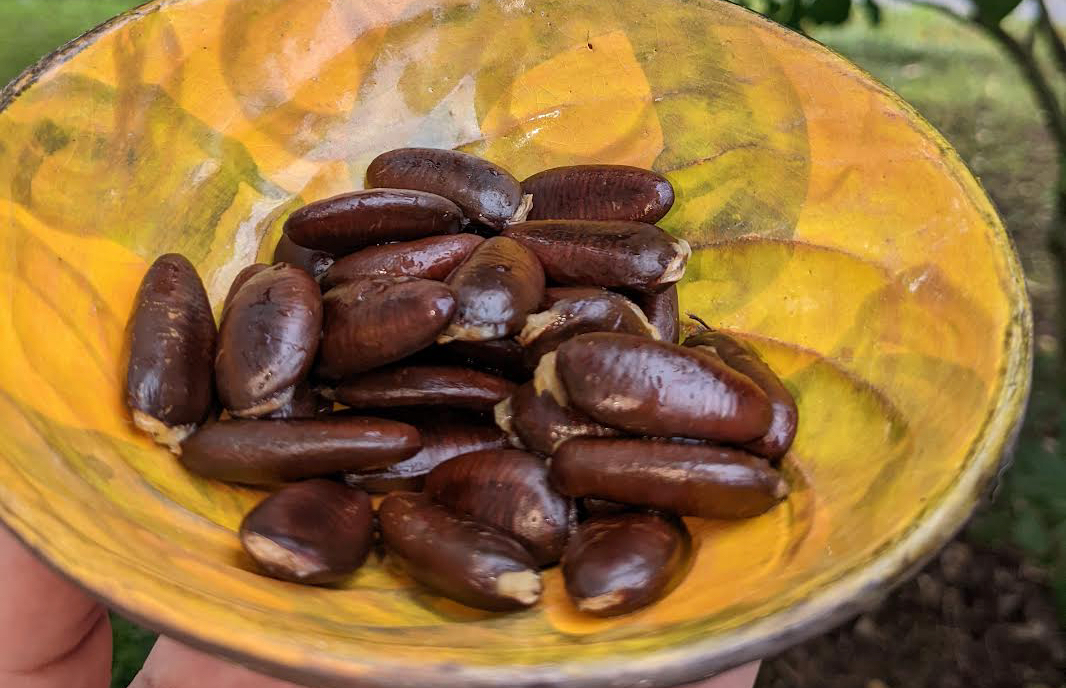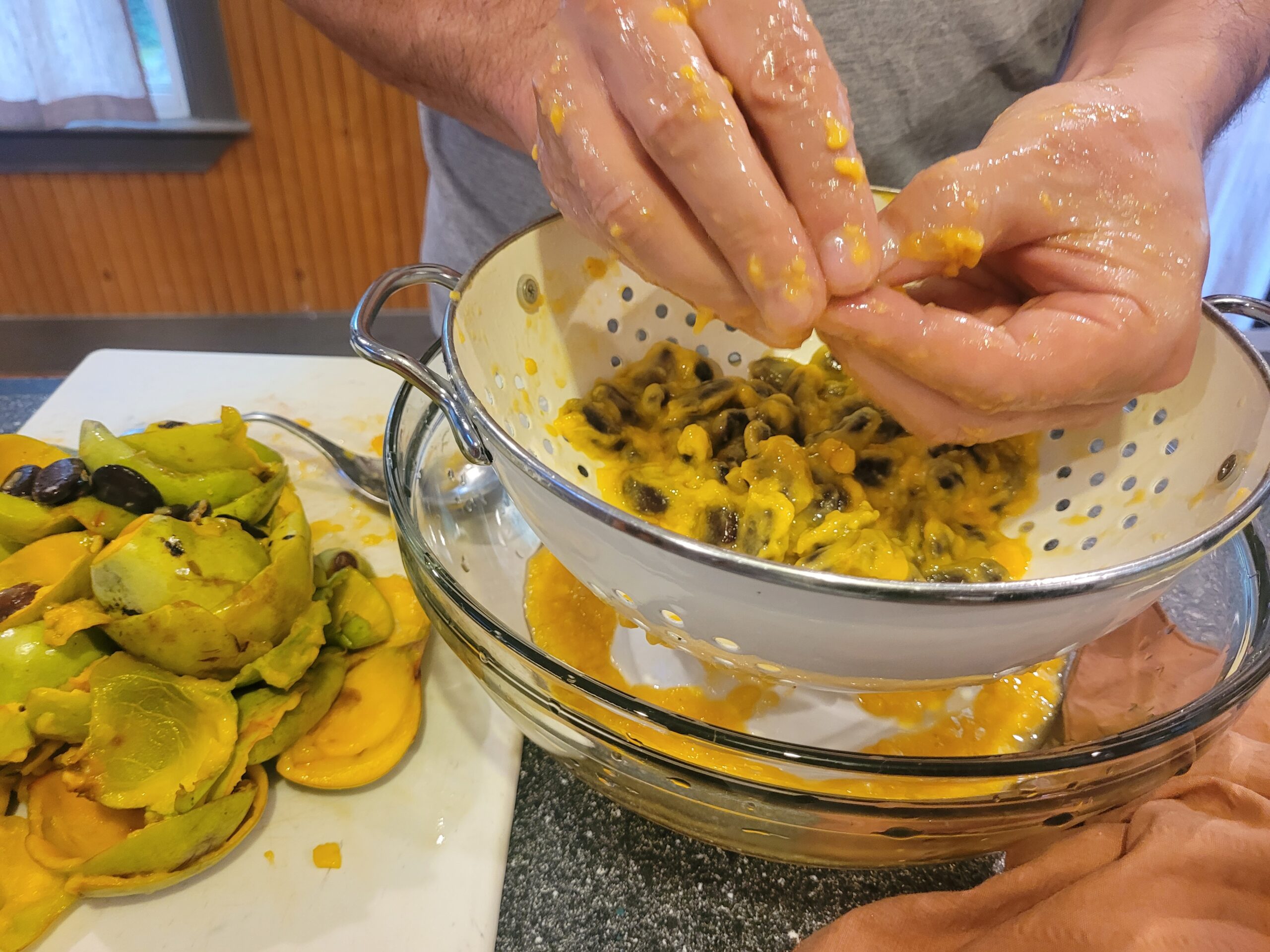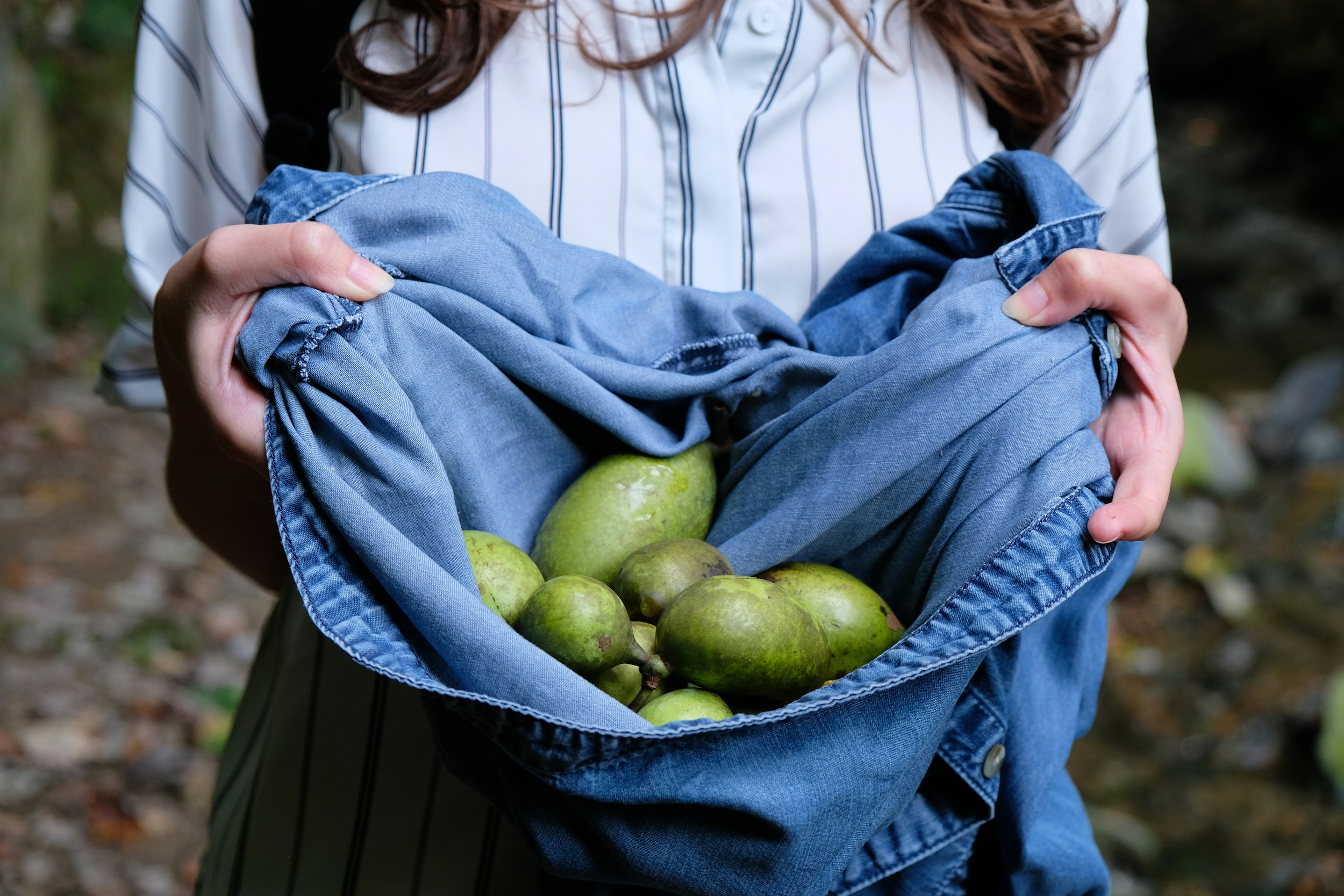NORTH STARS:
Production & Consumption
Heritage Value
Carbon Footprint
“Pawpaws are special because they remind us that there are still mysteries out there to be uncovered, and things that require a bit of searching and effort.”
We all want what we can’t have. Lately, an increasing number of locavores crave the luscious, buttery pawpaw. How much of the appeal of this decadent fruit lies in its elusive nature, and how much lies in its inherent goodness?
You won’t know till you try for yourself. I sure didn’t.
Love at First Bite
Pawpaw (Asimina triloba) is native to 26 of the United States, and particularly thrives in Appalachia, where I was born and now live. Still, I heard little about the fruit until a decade ago, when I encountered an early version of The Pocket Pawpaw Cookbook by food librarian Sara Bir.
“You can’t find pawpaws just anywhere,” says Bir. “They’re native to the Rust Belt and Appalachian areas that our mainstream media often slags on or overlooks. This is a fruit we [Appalachians] can claim as our own, and with pride.”
For generations, pawpaws have grown wild in relative obscurity, often in shady groves along streams and rivers. While touted as the largest edible fruit in North America, it turns out they’re not: pumpkins are categorized as fruit and tend to be bigger. Still, pawpaws grow fairly large (up to six inches long) and are undeniably alluring. They bruise easily in transit, so they’re rarely found in markets.
“Even in the pawpaw zone,” says Bir, “You can’t just go to a store and buy them.”
This summer, I set my sights on finding and tasting pawpaw. In late August – the beginning of pawpaw season in Southern Appalachia – I made a pilgrimage to Taylors, South Carolina, where I’d hoped to attend the South Carolina Pawpaw Festival. Tough luck: the festival was sold out. Apparently, there were even more pawpaw fanatics in the world than I imagined.
That day, I desperately scanned Facebook Marketplace for a lead on someone willing to sell me fruit. In no time, a stranger met me in the parking lot of a strip mall, pulling soft pawpaws out of the hot trunk of his car like contraband.
The pawpaws were mushy and spotted and looked like big green potatoes – but they smelled like heaven. I took them to a riverbank, pulled out my pocket knife, and cut into the flesh. They tasted like heaven, too. Where had the pawpaw been all my life?

Pawpaw seeds. Image courtesy of Amy Bess Cook.
Pawpaw Fans in American History
Pawpaws weren’t always such a rarity. Indigenous communities long feasted on pawpaws: the Pawnee word for the fruit is riwahárikstikuc; the Choctaw call it umbi. Enslaved Africans not only used the pawpaw in folk medicine, but wore the seeds around their necks as amulets.
Founding fathers were big fans, too: Thomas Jefferson cultivated pawpaw trees and sent seeds to his buddies in Europe; George Washington’s favorite dessert was rumored to be chilled pawpaws.
Otherwise, rural peoples from all races and creeds have relied on them for centuries, giving rise to nicknames like “poor man’s banana” and “hillbilly banana.”
Given a once-universal appreciation of the pawpaw, what happened? Some scholars say the fruit simply never received the research funding that, say, apples did. Other historians argue that this was no accident, that the fruit was marginalized when it became heavily associated with poor folks and people of color.
In any case, these days, the pawpaw has emerged as a darling of the modern slow food movement. If you want in on the action, you’ll first have to find the fruit.
Finding Fellow Fruit Freaks
Once you embark on a quest for pawpaws, you’ll find a community of proselytizers, friendly fanatics eager to share the fruit. For newbies, Bir suggests checking out social media groups that are focused on pawpaws, or finding educational programs at local parks or nature centers. In virtual and real-life forums, seasoned foragers and growers can offer the best places in your area to grow and glean pawpaws.
“I find that putting your curiosity about pawpaws out there is what opens doors,” she says.
While I missed out on the pawpaw festival near me, there are many more pawpaw celebrations across the Eastern United States, including in Virginia, Kentucky, and New York. Ohio’s festival is said to be particularly raucous. Check this site for details.
How to Enjoy Pawpaw
“Pawpaws are a joy to work with,” says Amie Fields, co-owner of Botanist and Barrel Winery and Cidery in North Carolina. After producing three different pawpaw ciders and a pawpaw cocktail, she should know.
“You need to remove the skins and the seeds, which is very tedious if you’re doing it by hand,” says Fields. “It took us a long time to figure out how to do that well, but when we figured out how to rig up an Italian tomato strainer to do it, that changed everything.”
The importance of removing skins and seeds cannot be overstressed: both are highly poisonous.
“Pawpaw seeds contain alkaloid compounds which cause nausea and vomiting,” reports Sheri Crabtree, Horticulture Research and Extension Associate at Kentucky State University, “so it is important not to eat pawpaw seeds, or accidentally have seeds in your food processor or blender when making pawpaw recipes.”
Also advisable is to begin with raw or liquid pawpaw. According to Crabtree, cooked pawpaw can sometimes cause illness.
“We do occasionally hear from people who’ve gotten upset stomachs from eating cooked pawpaw…We don’t know exactly what causes this, but it is something we would like to look into in the future.”
Bir, who literally wrote the book on cooked pawpaw, confirms: “Oh, this is definitely a thing. Pawpaws have compounds that can induce nausea …The presence of those compounds is variable from fruit to fruit. If you concentrate the pawpaw flesh in any way, it’s going to concentrate those compounds.”
This includes making fruit leather, which Crabtree and Bir both recommend against.
“Generally,” says Bir, “anytime you are eating wild foods for the first time you want to be moderate until you know how your body reacts.”
So get to know the pawpaw one bite at a time. Going slowly will not only help you adapt, it’ll extend your pleasure.
Sip on Botanist and Barrel Pawpaw Cider.
Make Sara Bir’s Pawpaw Lassi, recipe below.

Seeding and peeling pawpaw for a lassi. Image courtesy of Amy Bess Cook.
Pawpaw Lassi
By Sara Bir
from The Pocket Pawpaw Cookbook, reprinted with permission
You have worked hard for your pawpaws and deserve a refreshing reward. Here it is. This is thicker than an Indian lassi, more like a smoothie-lassi hybrid. The simple harmony of pawpaw and dairy is employed to full effect here. Instead of yogurt, I prefer thick and rich full-fat buttermilk. I’ve seen this in the store labeled as “country style” or “Bulgarian-style.” You can substitute plain yogurt (preferably full-fat).
Ingredients
1 cup pawpaw pulp
1 cup full-fat buttermilk
¼ cup cold water, plus more as needed
2-3 tsp. granulated sugar
Pinch ground mace, nutmeg, or cumin
Preparation
Combine the pawpaw pulp, buttermilk, water, and 2 tsp. of the sugar in a bowl or large glass measuring cup and whisk until combined. (You can use a blender instead, if you want the texture to be totally smooth.)
Taste and add more sugar if needed. You’re aiming for this to be very balanced: sweet, tart, creamy, fruity, all that. If it’s too thick to be pourable, thin it out with a few tbsp. of water at a time.
Garnish with a sprinkling of mace, nutmeg, or (if you’re feeling edgy) cumin, and serve immediately. Refrigerate leftovers for up to a day.

Amy Bess Cook is a writer with deep roots in the wine world. As founder of a pioneering platform amplifying female vintners, her work has earned recognition from media including The New York Times, and from colleagues as Imbibe magazine’s “Wine Person of the Year.” Her essays and articles have appeared in trade and lifestyle publications, including Wine Enthusiast. Follow Amy Bess on her Substack and IG @amybessyes.



